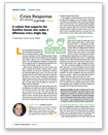
Life is full of stressful events and pressures. Sometimes circumstances can seem so overwhelming that it leads to anxiety, depression and life-threatening crises. Phoenix metro area and Northern Arizona residents who feel desperate and unable to cope can turn to Crisis Response Network (CRN), a non-profit organization dedicated to helping individuals by inspiring hope and empowering transformation from hope to health through a range of crisis services.
CRN has been providing crisis call center services since 2007, including mental health, substance abuse, suicide hotline services, and community coordination of services for individuals experiencing a crisis in the community, says President and CEO Justin Chase. CRN’s team of clinicians take calls 24/7, and a team of dispatchers coordinate and dispatch clinicians into the field, or coordinate transportation to get people to the services that they need. The non-profit’s goal is to keep people safe and healthy, and help them to remain within the community.
Chase says that CRN has a very high success rate, which he attributes to the staff’s hard work and compassion for the individuals with whom they interact. “We’re dealing with such a sensitive topic,” he says. “Our callers are often very desperate and in a horrific state of despair. Many times the call to our center is the last one the individual is planning to make so the way our team performs is critical. It’s not an easy line of work—it definitely takes a special team to achieve the favorable outcomes that they do.”
It also requires a nurturing workplace culture. Over the past two years, CRN’s leadership team has focused a great deal of attention on establishing a safe, caring and supportive culture. The effort has paid off in increased employee engagement, lower turnover and, most recently, industry recognition. CRN was honored by IQPC with a 2016 Call Center Week Excellence Award for Best Call Center Culture. For the non-profit, it was an impressive follow-up to last year’s win—the award for Best-in-Class Contact Center (Under 99 Seats).
Engaging a Multigenerational Workforce
Chase came on board two years ago with the goal of guiding CRN toward a more employee-centric model. He immediately set about transitioning the organization’s leadership style to better reflect its multigenerational workforce. While turnover in the contact center previously had been high, it was not due to the stressful nature of the work. The problems stemmed from the differing values, expectations and mindsets of a predominantly millennial workforce from those of a traditionalist leadership team. While traditionalists generally favor formal policies and a top-down chain of command, millennials don’t usually work well within such a rigid management structure.
“Our staff is among the youngest in the behavioral health field,” says Chase. “The previous leadership team was skilled at supporting the baby boomer generation, but that management approach doesn’t tend to work well with the emerging workforce. The former management style was perceived as being very punitive in nature, so the staff never felt safe. It created a disconnect, high turnover and lack of trust.”
Chase flipped the traditional hierarchy by taking a servant leadership approach and investing in the employee experience. He believes that the leadership team’s role is to serve the employees, which translates into better outcomes for employees and for those who contact the center.
 Practical pointer: Millennial employees want to know that their work is meaningful, Chase says. To get buy-in for change from millennials, it’s important to share the “why” behind decisions. “Understanding the long-term strategies and the intentionality behind each decision is fundamental,” he says. “If I can understand the why behind it, then it increases my ability to take ownership in supporting it.”
Practical pointer: Millennial employees want to know that their work is meaningful, Chase says. To get buy-in for change from millennials, it’s important to share the “why” behind decisions. “Understanding the long-term strategies and the intentionality behind each decision is fundamental,” he says. “If I can understand the why behind it, then it increases my ability to take ownership in supporting it.”
A Compelling Mission, Vision and Values
To focus the organization’s collective energy toward a common goal, one of Chase’s first tasks was to simplify CRN’s mission, vision and values. While the founding board had originally created a set of 12 guiding principles, he felt that there were too many and that they were too narrow in applicability.
After collecting feedback from the staff, Chase and the leadership team were able to pare down the mission to two important words: Inspiring Hope. “It was easy to identify and apply across the organization, and it fit well with the core function of what we do—no matter what your role, everybody can apply the mission of inspiring hope,” he says.
For the vision and values, Chase tasked the leadership team again to keep the vision simple, yet profound, and limit the values to three. CRN’s new vision—“Empowering transformation from HOPE to HEALTH”—clearly and effectively describes the organization’s goal to keep people safe, healthy and happy within the community. The three values the team came up with—“Compassion, Effort, Ownership”—can be applied across job functions.
Transitioning the mission, vision and values from concept to application began with a communications campaign. As a 24/7 operation, getting face time with both the executive team and individual employees was a challenge. Chase set up a series of “vision meetings,” and came into the center at all hours of the day and night to meet with groups of 10 employees at a time. “It was important for me to be able to sit down with the staff and share the vision we have for the organization going forward,” he says. The smaller groups kept the communication focused and personal. Staff members were presented with a copy of the mission, vision and values on a 5×7 card that they could take with them.
“Then we adopted the actions of living it,” he says. During the first year of the transition, the leadership team used the “Starfish Story” as a key theme to emphasize the power within each individual to make a difference in the lives of others (see below).
Company leaders continuously reinforce the mission with their staff. “Every meeting we have starts with a story of inspiring hope—whether it’s about somebody who we helped or a coworker or a community stakeholder,” Chase says.
In addition, performance goals and evaluations at every level were revised to reflect specific objectives tied to the mission, vision and values. “Staff, all the way through the organization, can see exactly what we’re all working toward,” he says.
THE STARFISH STORY

The Starfish Story, also known as The Star Thrower, was written by respected anthropologist and poet Loren Eiseley. It was published in 1969 in his collection of essays, “The Unexpected Universe.” The following is an adaptation of Eiseley’s tale.
A man was walking along the beach when he noticed a young boy picking up a starfish from the sand and throwing it into the ocean. He watched as the boy repeated the action over and over.
As he approached, he asked the boy, “What are you doing?” The boy replied that the tide was going out and if he didn’t throw the starfish back, they would die.
“Don’t you realize that there are miles and miles of beach and hundreds of starfish?” the man asked. “You can’t possibly make a difference.”
The boy bent down, picked up another starfish and threw it into the ocean. He smiled, turned to the man and said, “It made a difference for that one.”
Leaders Demonstrate Values on a Daily Basis
Chase believes that effective leadership is open, transparent and accessible. Today at CRN, the leadership team has daily contact with employees in every business area—but that wasn’t always the case.
When he joined the organization in 2014, Chase spent a considerable amount of time on the call center floor and sitting with staff members and listening to their feedback. He was shocked to learn that the staff’s perspective of the executive team was that they only saw them when they were coming to escort someone out, or for punitive reasons. “That’s not the way the face of this organization should be, and it’s not the way we should operate,” he stresses.
Chase looked for ways to break down the communication barriers between the leadership and the front line. The first step was to make sure that company leaders were more visible and accessible. “We established a practice by which every member of the executive team needs to walk through every suite and business area every day just to be available and to be a real human presence among our employees. If you have business on the floor, that doesn’t count as your trip. You have to intentionally visit the center or any of our suites where we operate and engage with employees without any agenda,” he explains, adding that: “The feedback we get from that is very powerful and valuable.”
Being human also meant that the executives needed to be more open, transparent and willing to talk about who they are and share their vulnerabilities, Chase says. He recalls that was difficult for some team members who were not used to talking about their families, personal interests and who they were outside of the workplace. Chase provided the team with a book, “The Gifts of Imperfection,” by Brene Brown. It proved to be very helpful in helping execs to get past their internal barriers and insecurities.
The staff’s response to the leadership’s team’s efforts has been highly positive. “Our employees have a very difficult job,” Chase says. “We have to be able to tap into who we are and bring that forward. Our willingness to be vulnerable in that regard greatly affects the staff and their building of trust with our leadership team.”





